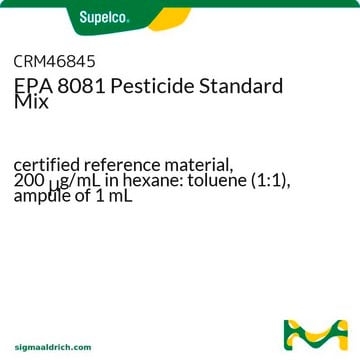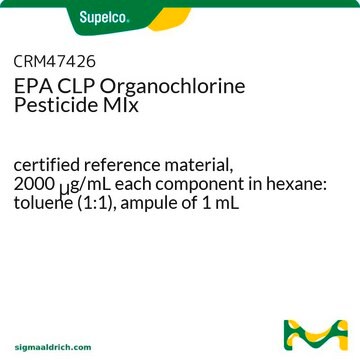61909
Atto Rho14 NHS ester
BioReagent, suitable for fluorescence
Sign Into View Organizational & Contract Pricing
All Photos(1)
About This Item
UNSPSC Code:
12352108
NACRES:
NA.32
Recommended Products
product line
BioReagent
Assay
≥90.0% (HPLC)
form
solid
manufacturer/tradename
ATTO-TEC GmbH
extent of labeling
≥90.0%
λ
in ethanol (with 0.1% trifluoroacetic acid)
UV absorption
λ: 624.0-630.0 nm Amax
suitability
suitable for fluorescence
storage temp.
−20°C
Application
Atto Rho14 NHS ester is a new rhodamine featuring a functionality for coupling to bio-molecules such as DNA, RNA or proteins. The label shows strong absorption and extraordinarily high fluorescence quantum yield. ATTO Rho14 is the brightest label available in this wavelength range. The dye exhibits an exceptionally high photostability. In common with most ATTO-labels, absorption and fluorescence are pH-independent in the range of pH 2 to 11, used in typical applications. The dye is moderately hydrophilic. After coupling to a substrate ATTO Rho14 carries a net electrical charge of +1.
Legal Information
This product is for Research use only. In case of intended commercialization, please contact the IP-holder (ATTO-TEC GmbH, Germany) for licensing.
Storage Class Code
11 - Combustible Solids
Flash Point(F)
Not applicable
Flash Point(C)
Not applicable
Certificates of Analysis (COA)
Search for Certificates of Analysis (COA) by entering the products Lot/Batch Number. Lot and Batch Numbers can be found on a product’s label following the words ‘Lot’ or ‘Batch’.
Already Own This Product?
Find documentation for the products that you have recently purchased in the Document Library.
Yuan-Qiang Sun et al.
Angewandte Chemie (International ed. in English), 51(31), 7634-7636 (2012-06-08)
Probes to dye for: Rhodamine-inspired Si-pyronine, Si-rhodamine, Te-rhodamine, and Changsha NIR dyes have been developed recently. These dyes show fluorescence in the far-red to near-infrared region, while retaining the advantages of the original rhodamines, such as high fluorescence quantum yield
Chao Ma et al.
Analytica chimica acta, 734, 69-78 (2012-06-19)
This article describes the design and preparation of a novel fluorescence resonance energy transfer (FRET)-based ratiometric sensor with the polymer nanoparticle as scaffold for detecting Hg(2+) in aqueous media. In this study, a fluorescent dye fluorescein isothiocyanate (FITC, served as
Raphael Alford et al.
Molecular imaging, 8(6), 341-354 (2009-12-17)
Fluorophores are potentially useful for in vivo cancer diagnosis. Using relatively inexpensive and portable equipment, optical imaging with fluorophores permits real-time detection of cancer. However, fluorophores can be toxic and must be investigated before they can be administered safely to
Jan Klohs et al.
Basic research in cardiology, 103(2), 144-151 (2008-03-08)
Light in the near-infrared (NIR) region between 700-900 nm can penetrate deep into living tissue, thereby offering a unique opportunity to use near-infrared fluorescence (NIRF) imaging techniques to detect and visualize fluorescent probes in-vivo. In the past few years, many
Chunbai He et al.
Biomaterials, 33(33), 8569-8578 (2012-08-22)
Polymeric nanoparticles have been widely applied to oral delivery of protein drugs, however, few studies focused on the systematical elucidation of the size-dependent oral absorption mechanism with well-defined polymeric nanoparticles. Rhodamine B labeled carboxylated chitosan grafted nanoparticles (RhB-CCNP) with different
Our team of scientists has experience in all areas of research including Life Science, Material Science, Chemical Synthesis, Chromatography, Analytical and many others.
Contact Technical Service



